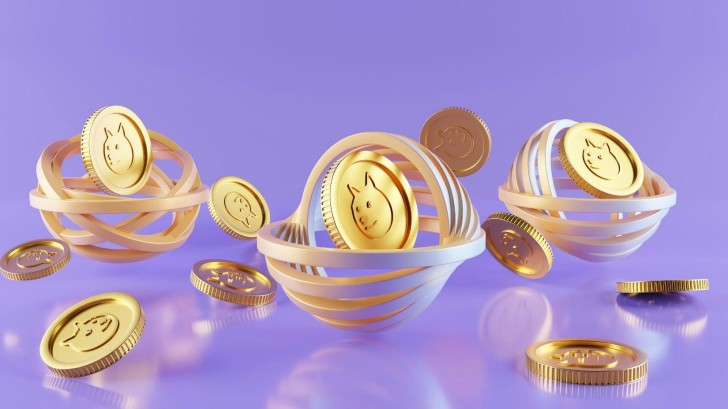Meme coins, on the other hand, have a history of high volatility moments fueled by social media and online influencers. This can be seen as a double-edged sword, as traders and investors can capitalize on rising prices for profits, whereas other inexperienced traders might lose the value of all their tokens.
The Dogecoin price has fluctuated several times when Elon Musk brought it to the headlines by posting about it on social media. However, this wasn’t an isolated case, as we’ll analyze other meme coins and their path to fame based on the factors that triggered their volatility.
Online hype
Online hype is one of the most powerful forms of marketing a product could take advantage of. However, while companies make efforts to create it and promote their services, startups in the crypto and blockchain industries that focus on meme coins don’t really have to do anything.
Meme coins are based on memes that everyone on the planet has used or laughed at at some point, making them more approachable and easier to understand. If we consider Pepe the Frog, a highly controversial meme given its usage by different parties, we can see how media hype transformed it into a profitable asset.
The beloved meme has become the basis for numerous different meme tokens, including PepeSol and Pepe Cash, as well as Pepe Dubai and Angry Pepe. The hype of another Pepe coin is keeping the original coin relevant, even though its use cases are not that expanded.
Well-written narratives
The narrative of a meme coin is important in moments of viral trends and fresh pop culture events. Shiba Inu, for instance, is a well-known Dogecoin competitor, as it’s also based on a dog meme. Still, its popularity surged as the team behind it was more present in the real world, actively calling for collaborations and participating in important projects. The Shiba Inu team co-organized a K-pop event in South Korea, where icons like Loco were present to play popular games with a crypto twist.
This announcement comes a few months after Shiba Inu entered into a deal with the UAE for a Web3 project in its public sector. This is the first-ever collaboration between a government entity and a cryptocurrency of this significance, revolutionizing the way business is conducted.
Here comes the narrative for Shiba Inu that made it so appealing for companies and promoters. The token’s story is one of empowering governments, businesses, and regular users to make the transition from Web 2.0 to Web 3.0 smoother. By adopting Shiba Inu, these institutions and individuals can benefit from secure payments, data control, and support economic growth.
FOMO
Unfortunately, FOMO is a prevalent phenomenon in the cryptocurrency world, but it is particularly pronounced in meme coins. That’s exactly because people will rush to buy or sell their meme coins at prices that allow them, fearing they’ll be left with obsolete assets.
The extreme price swings also contribute to the FOMO-induced volatility, as the psychological drivers fuel investors’ desire to buy in. Market sentiment tools can help users slow down or rally their next move, which is why meme coins are considered risky even for experienced traders.
MOONCAT is a prime example of FOMO in the meme coin sector, as the token surged 500% following a social media post. Those who were late to buy at the peak lost almost all the value in their tokens due to whales dumping theirs. Many meme coins experienced this, including PUPPY and even SHIB, as FOMO can cloud one’s judgment and send communities into a frenzy.
The case of Dogecoin
Dogecoin may have started as a joke, but things took a serious turn when Elon Musk became interested in it, both for its meme value and its potential value. In 2021, Dogecoin had a 339% price increase due to social media posts the “Dogefather” made. Similar posts continued to appear on apps, supporting the growth of the coin, but this also led to massive declines in value.
Dogecoin gained significance when people could use it to purchase Tesla products, which also contributed to price spikes following the announcement. Hence, the asset was and is subject to media pop culture, but the project hasn’t evolved significantly aside from this occurrence.
Dogecoin is useful in online purchases, tipping, and trading. In addition, several NGOs made it possible for people to donate using Dogecoin, allowing them to keep up with changing audiences and still make an impact.
Is trading meme coins a profitable and safe investment?
Trading meme coins is possible, but the level of safety and profitability depends on each individual’s risk tolerance and experience with volatility. Beginners should approach meme coins with caution and allocate the majority of their portfolio assets to established assets, such as Bitcoin, and introduce meme coins gradually. As Catherine Chen, Head of VIP & Institutional for Binance.com, stated, “Bitcoin is maturing into a macro-sensitive asset: increasingly influenced by monetary policy, central bank actions, and global money supply changes, rather than just crypto-native events like halving cycles.”
On the other hand, professional traders and investors can increase their meme coin allocation within their portfolios, especially if they’re able to use volatility to their own advantage and exit the transaction in time. However, this requires a certain level of skill, social media presence, and a well-established financial security plan.
What’s your take on meme coins?
Meme coins are successful coins whose communities support their development and path in the crypto world. Still, most lack clear use cases, so their value and prices are mainly supported by online hype and interest from prominent figures, which makes them unsafe for beginner traders. However, understanding the mechanisms by which their prices change can help anyone invest and trade, especially when considering how Dogecoin has evolved over the years.
 Editorial staff
Editorial staff

 Editorial staff
Editorial staff


